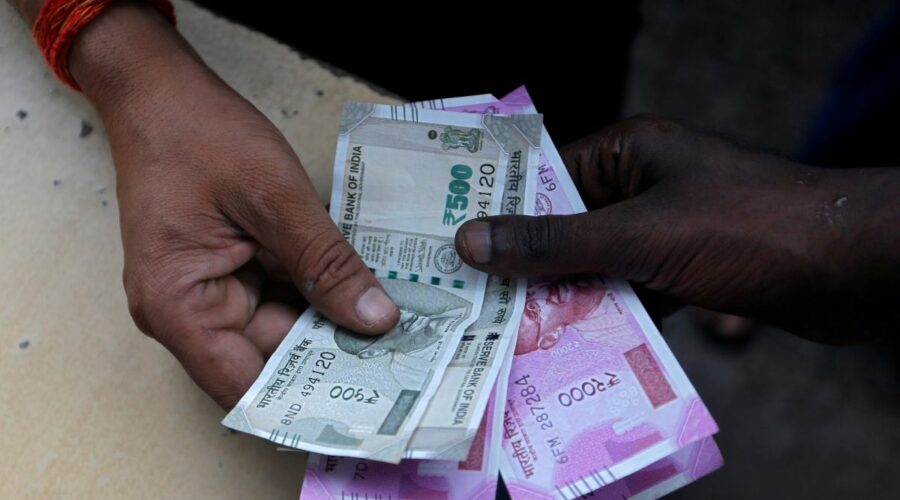‘Nothing alarming about fall in Indians’ savings’
‘As long as economic growth remains steady, creating jobs and generating stable incomes, the rise in home loans should not create problems.’
‘If the growth trajectory changes course over the medium term and interest rates rise along with inflation, the expanding trend in home loans may not sustain.’
India’s household savings fell to a five-decade low of 5.1% of GDP in Financial Year 2023, revealed the latest Reserve Bank of India data.
This was down from 7.2% in FY 2022, and suggests that a severe income crunch could be a way of life for Indians in future.
Whether this is a sign of worry or just a passing year post the COVID-19 pandemic, is not clear.
To understand more about the implications of the RBI data, Syed Firdaus Ashraf/Rediff.com spoke to Economist Prasenjit Bose.
The RBI data shows that net financial assets of households fell to a nearly five-decade low of 5.1% GDP in FY23, down from 7.2% in FY 22 and 11.5% in FY 21. What does it reflect about the state of our economy?
The trend reflects a release of pent-up consumption demand, which was squeezed due to the lockdown restrictions following the Covid pandemic. With economic recovery, consumption expenditure has risen and a large part of that spending has been driven by credit.
Bank lending has shifted focus from industrial credit to personal loans like housing loan, vehicle loan, education loan etc. Besides the commercial banks, NBFC lending has also risen sharply. This has resulted in a rise in household financial liabilities and decline of net financial assets of households in FY 23.
But it is too early to draw conclusions regarding long-term trends in household consumption and savings.
Does it mean we should not go by the headlines that India’s household financial savings is at a 50-year low?
Yes, you cannot arrive at strong conclusions only on the basis of one year’s data.
India’s household debt to GDP is much lower than other advanced economies or China. It is broadly comparable with that of Brazil or South Africa. There is nothing alarming in it yet.
There is a debt-driven expansion of household expenditure after a deep recession caused by the Covid pandemic in FY21. We need to see whether this expansion sustains over the medium to long term.
Has India witnessed a K-shaped recovery after Covid with the consumption of only a section of Indians growing fast while the others are left behind. Because imports of alcohol, and exotic fruits which the elites consume have risen drastically?
K-shaped recovery is true not only for India, but most other countries around the world. Inequalities of income, consumption and wealth have been rising before the recession and the same trend has continued during the recovery. India is one of the most unequal countries in the world.
India is also an import-intensive economy. During the phase of rapid economic growth from 2004 to 2011, the current account deficit eventually widened beyond sustainable levels because of burgeoning imports.
High global oil prices were a factor, but import of non-oil commodities like gold, capital goods, and electronic equipment also played a role.
Even today, India does not produce or manufacture many of the commodities that Indians consume, especially the higher income groups.
Stagnant wages is also a factor that people are talking about. Is that the reason for lower savings?
You can add high retail inflation to buttress the point about stagnant real wages. But we need to observe longer term trends to draw macroeconomic conclusions about household savings behaviour.
An average Indian household holds 77 percent of its total assets in real estate. Does it mean Indians are getting into debt more due to housing loans?
Your data may be correct, a large component of household savings is held in physical or non-financial assets like housing or real estate.
From the lenders’ point of view, scheduled commercial banks including the public sector banks took a beating over the last decade due to big ticket loans to large corporates and the infrastructure sector.
NPA accumulation reached unprecedented levels and they have been brought down in recent years only through massive NPA write-offs and haircuts, leading to banking sector losses.
Since 2014 there has been a shift away from industrial credit towards personal loans, in which housing loans is the largest category.
There is excess demand for housing and real estate in metropolitan cities, which is why their prices keep rising. India has an acute shortage of affordable housing everywhere. The rise in housing loans reflect the trend of rising demand for residential housing.
What are the risks associated with this spurt in home loans?
We need to look at longer term trends. India’s mortgage lending market is still evolving. So far the NPA rates are low, especially compared to industrial credit. The overall household debt to GDP level should not cause alarm yet.
Problems arise when there is large scale subprime lending like what had happened in the United States before the financial crisis of 2007-2008. Indian regulators need to be watchful in this regard.
As long as economic growth remains steady, creating jobs and generating stable incomes, the rise in home loans should not create problems.
If the growth trajectory changes course over the medium term and interest rates rise along with inflation, the expanding trend in home loans may not sustain.
Source: Read Full Article

